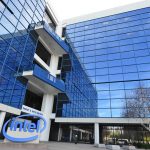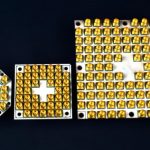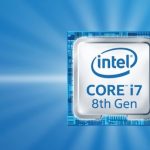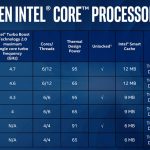Why Intel Insists Rumors Of The Demise Of Moore’s Law Are Greatly Exaggerated
For Intel, it was an important announcement: Moore’s law is not dead.
Before a gaggle of tech writers and analysts, company officials last week displayed charts and illustrations showing how transistor density on an integrated circuit continues to double every two years—consistent with a prediction made more than five decades ago by Intel cofounder Gordon Moore.
The intended message: Intel hasn’t lost its zeal for big leaps in computing, even as it changes the way it introduces new chips, and branches beyond the PC processor into other areas like computer vision and the internet of things.
“Number one, too many people have been writing about the end of Moore’s law, and we have to correct that misimpression,” Mark Bohr, Intel’s technology and manufacturing group senior fellow and director of process architecture and integration, says in an interview. “And number two, Intel has developed some pretty compelling technologies … that not only prove that Moore’s law is still alive, but that it’s going to continue to provide the best benefits of density, cost performance, and power.”
But while Moore’s law soldiers on, it’s no longer associated with the types of performance gains Intel was making 10 to 20 years ago. The practical benefits of Moore’s law are not what they used to be.
Slower steps, bigger leaps
For each new generation of microprocessor, Intel used to adhere to a two-step cycle, called the “tick-tock.” The “tick” is where Moore’s law takes effect, using a new manufacturing process to shrink the size of each transistor and pack more of them onto a chip. The subsequent “tock” introduces a new microarchitecture, which yields further performance improvements by optimizing how the chip carries out instructions. Intel would typically go through this cycle once every two years.
But in recent years, shrinking the size of transistors has become more challenging, and in 2016, Intel made a major change. The latest 14 nm process added a third “optimization” step after the architectural change, with modest performance improvements and new features such as 4K HDR video support. And in January, Intel said it would add a fourth optimization step, stretching the cycle out even further. The move to a 10 nm process won’t happen until the second half of 2017, three years after the last “tick,” and Intel expects the new four-step process to repeat itself.
This “hyper scaling” allows computing power to continue to increase while needing fewer changes in the manufacturing process. If you divide the number of transistors in Intel’s current tick by the surface area of two common logic cells, the rate of improvement still equals out to more than double every two years, keeping Moore’s law on track.

“Yes, they’ve taken longer, but we’ve taken bigger steps,” Bohr said during his three-hour presentation.
Why didn’t anyone draw this seemingly obvious conclusion sooner? Intel says its competitors in the semiconductor fabrication business have been muddying the waters, either using metrics that can’t be quantified, or moving to new manufacturing processes despite smaller gains in transistor size. With the metric Intel is now using, the company estimates that competitors are about three years behind in transistor density. And while chip makers do have a tendency to favor metrics that look flattering, Bohr says its methodology has been proposed by others in the industry before, and it can be verified by third parties.
“If company A doesn’t want to report their density using that metric, other companies, including a company that does reverse-engineering reports, can easily do the necessary measurements and report on that number,” Bohr says.
Gartner analyst Sam Wang agrees that Intel is being fair in its methodology, though he’s not sure whether the rest of the industry will follow along. He says it’s up to the media and analysts to popularize the measurement Intel is pushing.
“If all foundries agree to adopt this method, that would be a great comparison,” he says.
Moore’s Law in the real world
Despite the continued advancement of Moore’s law, the reality is that Intel’s processors aren’t making the performance leaps that they used to, and that was true even before the end of the tick-tock cycle. This chart from Elsevier is illustrative, showing that around 2003, processor performance gains dropped from 52% per year to 22% per year. Intel’s current 7th-generation Core i7 processor is a 15% improvement over the previous generation, and the upcoming 8th-generation Core i7 is expected to be similar.
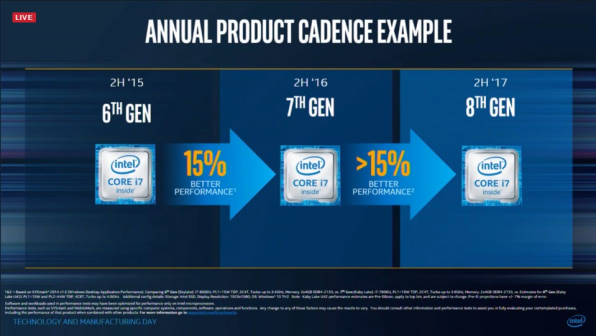
But while the 1990s and early aughts were a period of rapid growth in processing power due to innovations in process technology and microarchitecture, Moore’s law in itself does not weigh in on any particular performance improvement.
“Just to go back to the original papers by Gordon Moore, his prediction was that transistor density would double every two years. He didn’t make any statement about performance,” Bohr says.
Still, aren’t more powerful processors the point of this whole exercise? Not exactly. The real benefit of Moore’s law is to drive down the cost per transistor at a consistent rate. This does allow Intel to improve performance by adding more transistors as a way of improving performance, but it also just decreases the cost to produce new products. While Intel doesn’t disclose its exact cost per transistor, the company points out that cost declines are the same now as they were under the tick-tock cycle. And yes, there’s a graph to prove it.
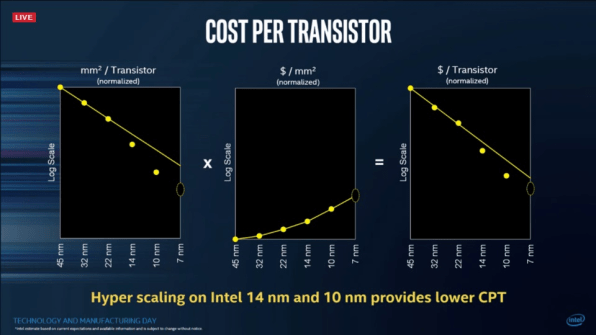
For present-day Intel, the main benefits of Moore’s law are probably more attractive than the incidental performance gains of 20 years ago. Amid up-and-down PC sales, Intel has been moving into other businesses, such as wearables and other small-scale connected products, and wants to take on Nvidia in AI for self-driving cars. Last year, the company also made a deal with ARM–whose architecture underpins most smartphone and tablet processors–to produce new chips on Intel’s upcoming 10 nm manufacturing process.
Adherence to Moore’s law, then, is no longer just about keeping Intel-powered PCs on the cutting edge.
“Following Moore’s law in terms of delivering better transistor density, lower transistor costs, and improved transistor performance and power, those benefits really apply to all product lines,” Bohr says, “whether we’re talking about a server part, a client part, or a low-power mobile part.”
Fast Company
(75)





